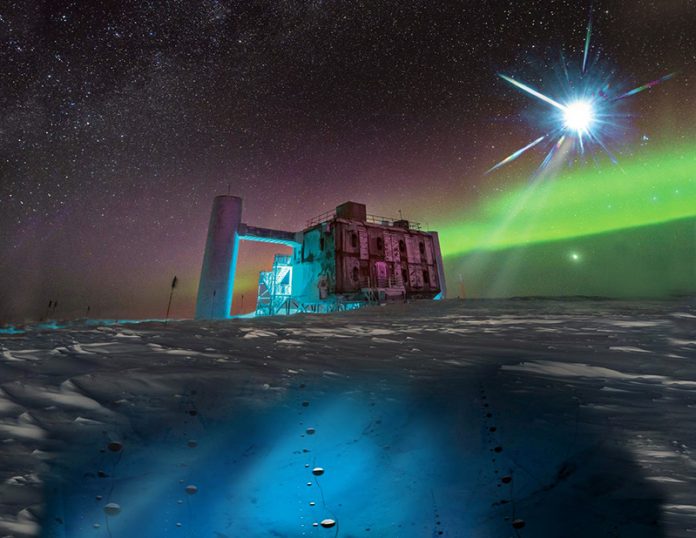
Audience
- Sentiment: Positive
- Political Group: Science enthusiasts
- Age Group: Young adults and older
- Gender: All genders
Overview
- ARCA telescope discovered a high-energy neutrino, KM3-230213A, with 220 PeV energy.
- Neutrinos provide insights into cosmic events and fundamental physics, including dark matter.
- The discovery signifies a major advancement in neutrino research and technology.
Unlocking the Secrets of the Universe: The Exciting Discovery of KM3-230213A
On February 13, 2023, a thrilling event occurred in the world of astrophysics. Scientists working with the ARCA (Astroparticle Research with Cosmics in the Abyss) neutrino telescope made an incredible discovery: a neutrino, named KM3-230213A, that boasted a jaw-dropping energy of about 220 PeV (Peta-electronvolts). This discovery is not just a scientific milestone; it is a peek into the mysterious world of neutrinos and their role in understanding the cosmos. Let’s dive deeper into what this means, why it’s important, and how scientists are working to uncover the more extensive mysteries of the universe!
What Are Neutrinos and Why Should We Care?
To appreciate this discovery, we first need to understand what neutrinos are. These tiny, nearly massless particles are sometimes called “ghost particles” because they are incredibly elusive. Despite being one of the most common particles in the universe, neutrinos hardly ever interact with ordinary matter. In fact, it’s estimated that trillions of neutrinos pass through our bodies every second without us noticing. They come from a variety of cosmic events, such as supernovae, the sun, and even our own Earth.
So, why should you care about these seemingly unimportant particles? Neutrinos hold essential clues about the universe’s fundamental workings. They can tell us about massive cosmic events (like exploding stars), the core processes of the sun, and even the very nature of dark matter. This means that by studying neutrinos, scientists can gain insights into some of the biggest mysteries of physics, such as how the universe formed and what it consists of.
The Incredible Discovery of KM3-230213A
Now, let’s get back to the exciting discovery made by the ARCA telescope. Located 3,450 meters deep in the Mediterranean Sea, off the coast of Sicily, the ARCA telescope is like a giant undersea detective. It employs a series of tall detection units spread out across significant distances beneath the water. One of the key tools these units use is something called photomultiplier tubes (PMTs), which are advanced devices that can detect the light from very faint events.
So how does this all work? When a neutrino interacts with water in the sea, it produces something called Cherenkov radiation—a faint light emitted when a particle moves through a medium faster than the speed of light in that medium. These detectors are designed to pick up that light, allowing scientists to infer information about the original neutrino and its properties.
The detection of KM3-230213A is particularly remarkable because its energy level of 220 PeV is extraordinarily high. To put this into perspective, a typical neutrino might have an energy on the order of GeV (giga-electronvolts), which is a million times less than that of KM3-230213A! This makes it one of the highest-energy neutrinos ever detected, and it has scientists buzzing with excitement.
What This Means for the Future of Neutrino Research
This initial detection is just the beginning for ARCA. As the project continues to expand with more detectors expected to be installed off the coasts of France and Greece, scientists hope to detect even more high-energy neutrinos. Each new discovery adds a piece to the puzzle of understanding where these high-energy particles come from. Some possible sources include:
- Supernovae: When a massive star exhausts its nuclear fuel, it can collapse and explode into a supernova, releasing a significant amount of energy and producing high-energy particles, including neutrinos.
- Gamma-Ray Bursts: These are intense bursts of gamma rays that might originate from extremely energetic processes in the universe, such as the collision of black holes or neutron stars.
- Active Galactic Nuclei: Certain galaxies have supermassive black holes at their center, and as matter spirals into these black holes, it can emit high-energy neutrinos.
The information gathered from the ARCA telescope can help scientists identify and study these cosmic events better, leading to more profound insights into the universe and its workings.
The Technology Behind the Detection
While the discovery of KM3-230213A is exciting, much of its success is credited to the advanced technology used by researchers. One significant component is the aforementioned photomultiplier tubes. These tubes are incredibly sensitive devices that amplify light signals, allowing scientists to detect the fleeting flashes of light generated by Cherenkov radiation.
But what if you think that detecting neutrinos is straightforward? Many people believe that detecting these elusive particles is an easy task. However, creating a telescope like ARCA is an enormous effort that involves cutting-edge technology and cooperation among scientists worldwide. In fact, each of the photomultiplier tubes needs to be manufactured with extreme precision to detect even the tiniest hints of light produced by neutrinos. Problems can arise when detectors fail or produce false readings, which complicates the job even further.
Addressing Misconceptions in Neutrino Research
Despite the intricate work that goes into neutrino detection, misconceptions sometimes arise about the technology used. Some critics might argue that previous incidents, like the failure of another neutrino detection project, indicate that ARCA’s findings shouldn’t be taken seriously. However, it’s essential to remember that science is a continuous journey of exploration and discovery. The setbacks and challenges faced by previous projects have paved the way for the current advancements in technology and methods.
The ARCA telescope has learned from these experiences and continues to evolve. Just like how scientists believed the earth was flat before uncovering new knowledge, our understanding of neutrinos and the universe at large is an ever-developing field. The excitement about discoveries such as KM3-230213A is proof that there are still many mysteries to explore.
Conclusion: A Journey Awaits
With the recent discovery of KM3-230213A, we are reminded that the universe is full of wonders, waiting to be unlocked. Each neutrino detected opens a new chapter in our understanding of the cosmos, and who knows what insight the next detection will provide? So next time you look up at the night sky, think about the hidden particles flowing all around us and the vast universe beyond our little blue planet.
As scientists continue their quest to unravel the universe’s mysteries, one question lingers: what do you think the next discovery in neutrino research will be? Share your thoughts, theories, or questions in the comments below!






